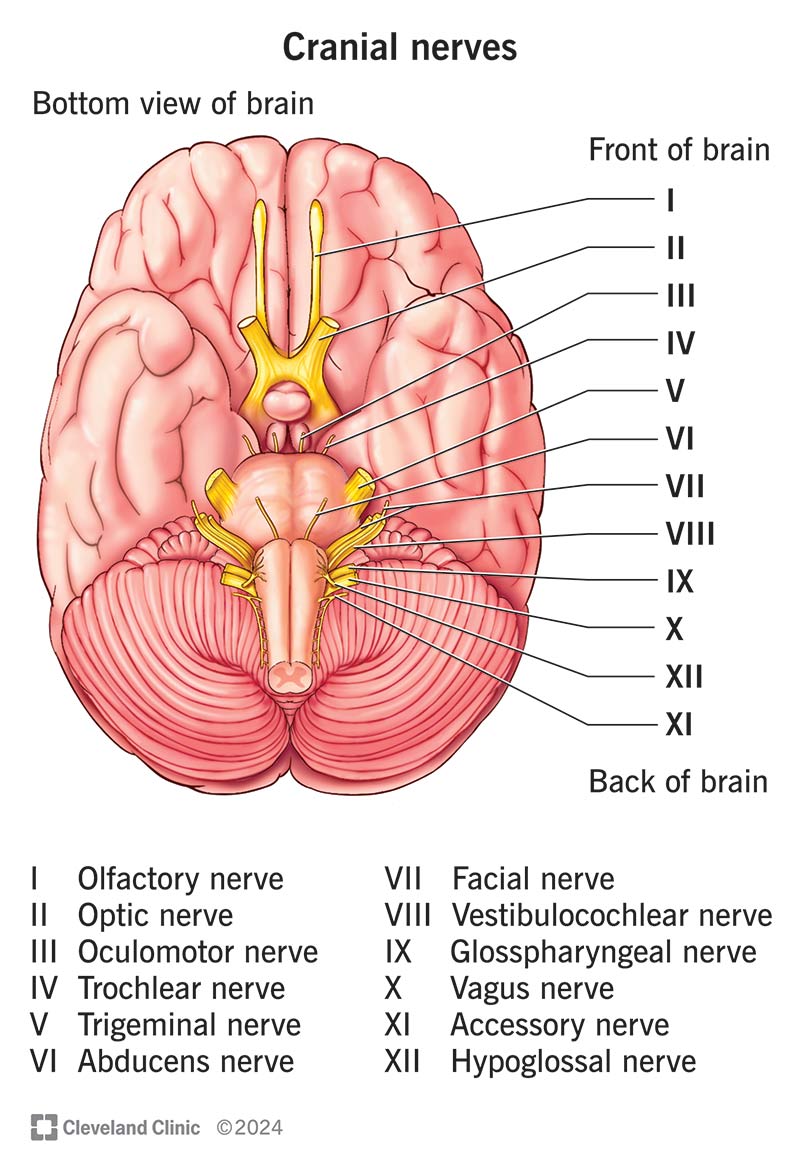Your cranial nerves are a set of 12 paired nerves that stem from your brain. They have a wide variety of functions, including helping you see, taste, smell, hear and feel sensations. They also help you make facial expressions, blink your eyes and move your tongue.
Advertisement
Cleveland Clinic is a non-profit academic medical center. Advertising on our site helps support our mission. We do not endorse non-Cleveland Clinic products or services. Policy

Your cranial nerves are a set of 12 nerves that send electrical signals between your brain and different parts of your head, face, neck and torso. These signals help you see, smell, taste, hear and move your facial muscles. Your cranial nerves begin toward the back of your brain. They’re a key part of your nervous system.
Advertisement
Cleveland Clinic is a non-profit academic medical center. Advertising on our site helps support our mission. We do not endorse non-Cleveland Clinic products or services. Policy
You might first think of your eyes, nose, ears and mouth when it comes to using your senses. But these body parts don’t work properly without healthy cranial nerves. You can also thank your cranial nerves for allowing you to make facial expressions and communicate.
You have 12 cranial nerve pairs. Each nerve pair splits to serve the two sides of your brain and body. For example, you have one pair of olfactory nerves. One olfactory nerve is on the left side of your brain, and one is on the right side of your brain.
Your cranial nerves play a role in relaying sensory and/or movement (motor) information.
Sensory nerves can help you:
Motor nerves play a role in controlling specific muscles. Some cranial nerves have both sensory and motor functions.
Your 12 cranial nerves each have a specific function. Healthcare providers categorize the cranial nerves based on number and function:
Advertisement
Two of your cranial nerve pairs — your olfactory and optic nerves — begin in your cerebrum and branch out to their target tissues. The cerebrum is the largest portion of your brain that sits above your brainstem.
The other 10 pairs of cranial nerves start in your brainstem and then branch out. Your brainstem connects your brain and spinal cord.
The longest cranial nerve is your vagus nerve. It runs from your brain to your large intestine, innervating several tissues along the way.
When a cranial nerve experiences damage, it doesn’t function as it should. This may cause specific movement or sensory issues, depending on its underlying function. Several conditions and situations can affect the functioning of your cranial nerves, like:
When there’s an issue with a specific cranial nerve that has a motor (movement) function, healthcare providers often call it a palsy. “Palsy” means “paralysis.” A palsy results in muscle weakness and movement issues.
Examples of cranial nerve palsies include:
Another specific type of cranial nerve condition is trigeminal neuralgia. This condition causes episodes of intense facial pain that can disrupt your everyday activities. It typically happens when a blood vessel puts pressure on your trigeminal nerve.
Some cranial nerves, like your optic nerve and vagus nerve, can have several types of dysfunction. For example, conditions that affect your optic nerve include glaucoma and optic neuritis. Conditions that can arise from vagus nerve dysfunction include gastroparesis and vasovagal syncope (fainting).
Advertisement
Some cranial nerve conditions are unpreventable. But you can help keep your brain, cranial nerves and entire nervous system healthier with these steps:
The symptoms of cranial nerve injuries or conditions vary depending on which nerve is affected. Contact your healthcare provider if you experience:
Cranial nerve mnemonics are memory devices to help you remember the names of the nerves in order of one through 12. They can also help you remember whether the nerves are sensory, motor or both.
Cranial nerve mnemonics to remember the names of the nerves in order include:
Advertisement
It’s important to note that in these mnemonics, “some” and “such” refer to another name for the accessory nerve: spinal accessory nerve.
To remember cranial nerve functions, the words in the mnemonic start with:
The word order mirrors the numerical order of nerves one through 12:
Without your cranial nerves, it’d be impossible to experience the world around you — from seeing and hearing to smelling and tasting. They’re also essential for moving your eyes, tongue, mouth and various parts of your face. It’s easy to take these nerves for granted until something goes wrong. If you develop sudden issues with your senses or have symptoms related to functions involving your face, an issue with a cranial nerve may be the cause. It’s important to see a healthcare provider if this happens — they can get to the bottom of the issue.
Advertisement
If you have a neurological condition, you want expert advice. At Cleveland Clinic, we’ll work to create a treatment plan that’s right for you.

Last reviewed on 08/15/2024.
Learn more about the Health Library and our editorial process.